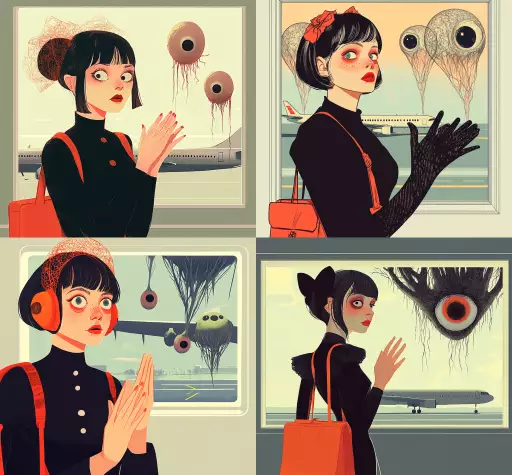Explore the Best AI Image Gallery

AI-Generated Images: Reshaping the Design Landscape
The world of design is undergoing a rapid transformation, fueled by the emergence of artificial intelligence (AI) and its ability to generate stunning visuals. AI-powered image generation tools are no longer confined to the realm of science fiction; they are becoming increasingly sophisticated and accessible, empowering designers with new possibilities and challenging traditional creative workflows.
Potential Uses in Design
AI-generated images offer a wide range of applications across various design disciplines:
- Logo Design: AI can assist in generating unique and memorable logos based on specific brand guidelines or concepts.
- Marketing & Advertising: Creating eye-catching visuals for social media campaigns, websites, and marketing materials.
- Product Design: Generating conceptual designs and exploring different iterations of products before physical prototyping.
- Illustration & Concept Art: Producing unique illustrations, concept art, and storyboards for books, films, and games.
- User Interface (UI) & User Experience (UX) Design: Generating mockups and prototypes for websites and applications, enhancing the user experience.
Benefits of AI-Generated Images
The integration of AI into design workflows brings several notable benefits:
- Efficiency & Speed: AI can significantly accelerate the design process by generating multiple variations of images in a short timeframe.
- Cost Savings: Reducing the need for extensive manual design work can lead to cost savings for businesses and individuals.
- Exploration & Innovation: AI can help designers explore unconventional ideas and push creative boundaries.
- Accessibility: Making design tools more accessible to non-designers by simplifying the image creation process.
Ethical Considerations
While AI-generated images offer immense potential, its crucial to address ethical considerations associated with their use:
- Copyright & Ownership: Questions surrounding the ownership of AI-generated artwork and the rights of creators.
- Bias & Representation: Ensuring that AI algorithms are trained on diverse datasets to avoid perpetuating biases in generated images.
- Transparency & Accountability: Clearly communicating the use of AI in design processes and establishing accountability for generated content.
- Job Displacement: Addressing the potential impact of AI on the livelihoods of human designers.
Future Trends
The field of AI-generated images is constantly evolving. Here are some anticipated future trends:
- More Realistic & Customizable Images: Continued advancements in AI algorithms will result in more realistic and customizable image generation capabilities.
- Integration with Other Technologies: Seamless integration of AI image generation with virtual reality (VR), augmented reality (AR), and other emerging technologies.
- Personalized Design Experiences: AI-powered tools enabling users to create personalized designs tailored to their specific needs and preferences.
- Ethical Frameworks & Regulations: The development of ethical guidelines and regulations to govern the responsible use of AI in design.
AI-generated images are poised to revolutionize the design industry, offering exciting possibilities for creativity, efficiency, and innovation. By embracing these advancements while addressing ethical considerations, designers can harness the power of AI to shape the future of visual communication.














![**Representation: A teenager smiling while thinking about a friendly dog, a comic-style thought bubble with a friendly dog inside. Graphic style: Line drawing, cartoon style, influenced by Franco-Belgian comics, thick black lines, simplified design, vector, black and white only, in the style of Keith Haring or the French comic strip "Alinéa". [IMPORTANT]: A single continuous line extending from one side of the image to the other, minimalist, strong outlines, line drawing, without lifting the hand, ultra-simplified, no shading, entirely white image, drawing created in the center of a sheet of paper. --ar 16:5** - <@627984126871470085> (fast)](https://images.ai-img.art/thumbnails/150/6fc850f638e3dee0c4b121acecad2c8419e02bdeac7f871d625f1003c1c3abe1.webp)


](https://images.ai-img.art/thumbnails/150/157712d76865d557120f9baf988de3d0525225295a2789c89bf2c4a5a96a03d1.webp)



![**Representation: A dog acting as a private tutor to a child. The dog holds a ruler in its paw and stands at the blackboard to explain a dog diagram to the child. Graphic style: Line drawing, cartoon style, influenced by Franco-Belgian comics, thick black lines, simplified design, vector, black and white only, in the style of Keith Haring or the French comic strip "Alinéa". [IMPORTANT]: A single continuous line extending from one side of the image to the other, minimalist, strong outlines, line drawing, without lifting the hand, ultra-simplified, no shading, entirely white image, drawing created in the center of a sheet of paper. --ar 16:5** - <@627984126871470085> (fast)](https://images.ai-img.art/thumbnails/150/7a854648a81e51241dcca8d24dd6e3bfcf07ad1df51baf401c9b729f4cf411fa.webp)

![**Representation: A dog acting as a private tutor to a child. The dog holds a ruler in its paw and stands at the blackboard to explain a dog diagram to the child. Graphic style: Line drawing, cartoon style, influenced by Franco-Belgian comics, thick black lines, simplified design, vector, black and white only, in the style of Keith Haring or the French comic strip "Alinéa". [IMPORTANT]: A single continuous line extending from one side of the image to the other, minimalist, strong outlines, line drawing, without lifting the hand, ultra-simplified, no shading, entirely white image, drawing created in the center of a sheet of paper. --ar 16:5** - Variations (Strong) by <@627984126871470085> (fast)](https://images.ai-img.art/thumbnails/150/f4e034998ccd869d8a061fd12017514fcd92210eb33d4222dc9b54716223f4dd.webp)







](https://images.ai-img.art/thumbnails/150/9d51c5e673b4f2068b7b01abc35425a06f173b76303adf9ad29ca14302c25b18.webp)








](https://images.ai-img.art/thumbnails/150/51c93500396faff4e7fa8b42bc68033067b16b2230e3496e95c482a581ff0fe9.webp)



